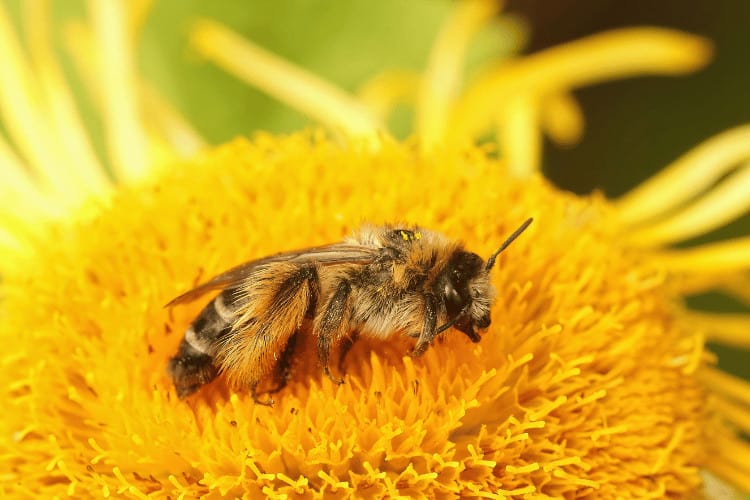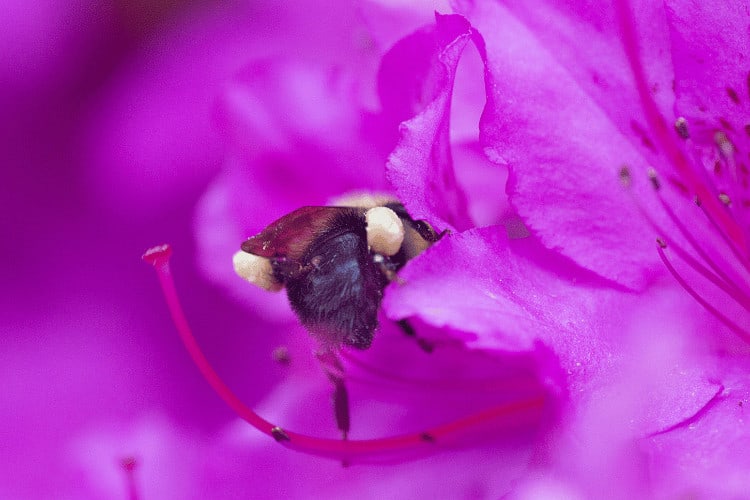Pantaloon Bees: Characteristics, Behavior, Nesting, and More!
Pantaloon bees are a small group of bees found in sandy and sunny habitats around the world. They have this name because of the distinctive orange pantaloons on their hind legs.
These bees aren’t as common as other bee species, so it can be a bit challenging to find and keep them. Still, if you’re curious about these tiny creatures, I’m here to give you some insight into the lives of these quirky bees.
In this article, I’ll share everything I know about their appearance, behavior, habitat, and nesting habits. I’ll also answer some questions that may be on your mind about pantaloon bees.
So, without further ado, let’s get started!
Physical Description and Personality Characteristics of Pantaloon Bees

The scientific name of the pantaloon bee is Dasypoda hirtipes. It’s the only bee species in the genus Dasypoda, which belongs to the bee family Melittidae.
Now, why don’t we take a closer look at this bee’s appearance and behavior?
Physical Appearance
Dasypoda hirtipes are fuzzy creatures with a distinctive appearance and bodies on the larger side compared to other bee species. The pantaloon bee females are usually 11 to 16 mm long, while the males are typically shorter.
It was pretty surprising for me to know that since it’s mostly the opposite in other insects and animals!
Melittid bees are known for the dense covering of hair on their legs. These hairs form a pollen basket on the hind legs of females, which is used to collect pollen from flowers. The hairs on the legs of male pantaloon bees aren’t as thick.
These bees have golden hairs that are sometimes of a pale yellow hue. The body itself comes in a shade of brown or orange.
The wings of the pantaloon bee are transparent, folding neatly over the back when it’s not in flight. The abdomen is striped black and gold, with the stripes becoming narrower toward the elongated end.
Character and Behavior
Pantaloon bees are solitary bees; each female bee builds a nest and takes care of her young. These bees don’t live in a hive-like structure, and they don’t have hierarchies like other bee species.
Plus, they aren’t aggressive and are less likely to sting. I’ve never been stung by a pantaloon bee, even when I’ve gotten close to it.
Keeping Pantaloon Bees
Pantalone bees aren’t a typical choice for beekeepers, but they would be easy to keep because they’re docile. They’re somewhat rare and difficult to find, so it may be challenging to obtain them for a beginner.
Still, if you’re interested in keeping pantaloon bees, you’ll need to provide them with a sandy area to build their underground nests. You should also offer them a suitable source of nectar and pollen, like certain types of flowers they’re most attracted to.
Don’t worry; I’ll go through that soon!
Pantaloon Bee Ideal Habitat and Flower Preferences
Pantaloon bees love sandy habitats, coastal regions, and sunny locations, such as coastal dunes, heathland, and salt marshes. They also frequent grasslands and meadows with an abundance of various flower types.
These pretty bees are nectar and pollen generalists, but they prefer to collect pollen from composite flowers, such as dandelions, daisies, and sunflowers.
They visit other flowers, too, including clover, knapweed, and raspberry.
Where Can You Find Pantaloon Bees?
Dasypoda hirtipes bees are mostly found in different regions across Asia and Europe.
You might see them in Italy, France, Germany, Austria, Bulgaria, and Switzerland. In Asia, they mostly live in Syria, Lebanon, and Turkey.
Pantaloon Bees Life Cycle, Mating, and Nesting
Pantaloon bees have a single generation per year. In other words, they’re described as a univoltine bee species.
Their life cycle starts in the spring when the female bees leave their nests and successfully mate with males. After copulation, the females dig burrows in the sandy ground and lay their eggs in individual cells.
The nests are typically exposed to full sun, each burrow about four to six inches long. Female pantaloon bees then line the burrows with pollen and nectar and lay a single egg in each cell.
The Dasypoda hirtipes female bee then seals the brood cells with mud.
After that, the eggs hatch into larvae, which feed on pollen and nectar that their mother has collected. Finally, the larvae pupate in the fall and emerge as adults the following spring.
Importance of Pantaloon Bees in Ecosystems and Agriculture
Pantaloon bees are excellent pollinators thanks to the fuzzy patches of hair on their legs. Pollen easily sticks to their pollen baskets, which makes them vital for the survival of their ecosystem.

For instance, they help pollinate a huge range of plant species, including:
- Dandelions
- Daisies
- Clover
- Knapweed
- Raspberry
- Heathers
- Dune plants
As you probably already know, these plants are essential food sources for many other animals, such as birds, butterflies, and bats. When Dasypoda hirtipes pollinate these plants, they ensure there is enough food for these other animals.
Pantaloon bees also pollinate crops, such as fruits, vegetables, and nuts. Many of these crops rely on pollination for their reproduction, meaning that these bees play a key role in our agricultural and economic needs.
Common Questions About Pantaloon Bees
Do you have more questions about the one-of-a-kind pantaloon bee? You might find an answer right below!
Are pantaloon bees dangerous?
Dasypoda hirtipes are by no means dangerous. They don’t have aggressive tendencies and aren’t known to sting unless you provoke them.
So, my advice to you as a seasoned beekeeper is to keep a polite distance from even the most docile type of bee. Otherwise, it’ll be compelled to defend itself, which you don’t want to experience!
If you’re still concerned about being stung by a pantaloon bee (if you’re lucky enough to find one), you can take a few precautions.
First, avoid getting too close to the bee. Second, don’t swat at the bee or make any sudden movements. If the bee stings you, the pain should be mild and should go away within a few minutes.
But in the case that you have an allergy to bee stings, act immediately and seek medical attention before things get out of hand.
How to attract pantaloon bees?

While they’re not often seen, you can increase your chances of witnessing pantaloon bees by sticking to a few guidelines:
- Plant a variety of flowers to encourage these bees to visit your yard.
- Choose native plants to grow in your garden over non-native plants. The former plants have evolved alongside local pollinators, so they’re more likely to be frequented by them.
- If you have a sandy area in your garden, you can make it even more attractive by adding some pebbles or other materials to create a more natural habitat.
- Avoid using pesticides. If you must do so, choose ones that are labeled as being safe for pollinators.
What do pantaloon bees eat?
Pantaloon bees are nectar and pollen generalists, meaning they don’t have a preference for a particular type of flower. They’ll typically visit a variety of flowers to collect nectar and pollen, which they use to feed themselves and their young.
Pollen is their main source of protein, while nectar gives them and their younglings some much-needed energy to go about their daily routine.
Still, Dasypoda hirtipes seem to have a thing for certain flowers of the aster family, like ragwort, fleabane, hawkbit, oxtongue, and cat’s ear.
What are some threats that pantaloon bees face?
Just like all bee species, pantaloon bees have their fair share of threats, including:
- Habitat loss and fragmentation: Pantaloon bees are a ground-nesting species, and they need sandy soil to build their nests. Habitat loss and fragmentation can make it difficult for these bees to find suitable nesting sites.
- Pesticide use: Pesticides can kill pollinators, including pantaloon bees.
- Climate change: Climate change is causing changes in weather patterns and plant flowering times. This can make it difficult for the bees to find food and mates.
- Invasive species: Invasive species can compete with pantaloon bees for food and nesting sites.
- Predators: Dasypoda hirtipes are naturally preyed upon by a variety of animals, including birds (swallows and flycatchers), mammals (like shrews), and insects (wasps and flies).
Final Words
Pantaloon bees are a solitary bee species that lives in coastal habitats and sunny areas. While they’re a bit hard to come across, they still play a vital role in agriculture and some ecosystems from behind the scenes.
Sadly, these bees face some threats, including habitat loss and fragmentation, pesticide use, climate change, invasive species, and predators. That’s why it’s important to take steps to protect these pollinators.
While rare, you can try to attract these unique bees by planting native flowers, avoiding pesticides, and creating pollinator-friendly habitats. However, if you don’t live in their natural range, it’ll be challenging to have Dasypoda hirtipes visit you.
I hope you enjoyed learning about these little quirky creatures!
